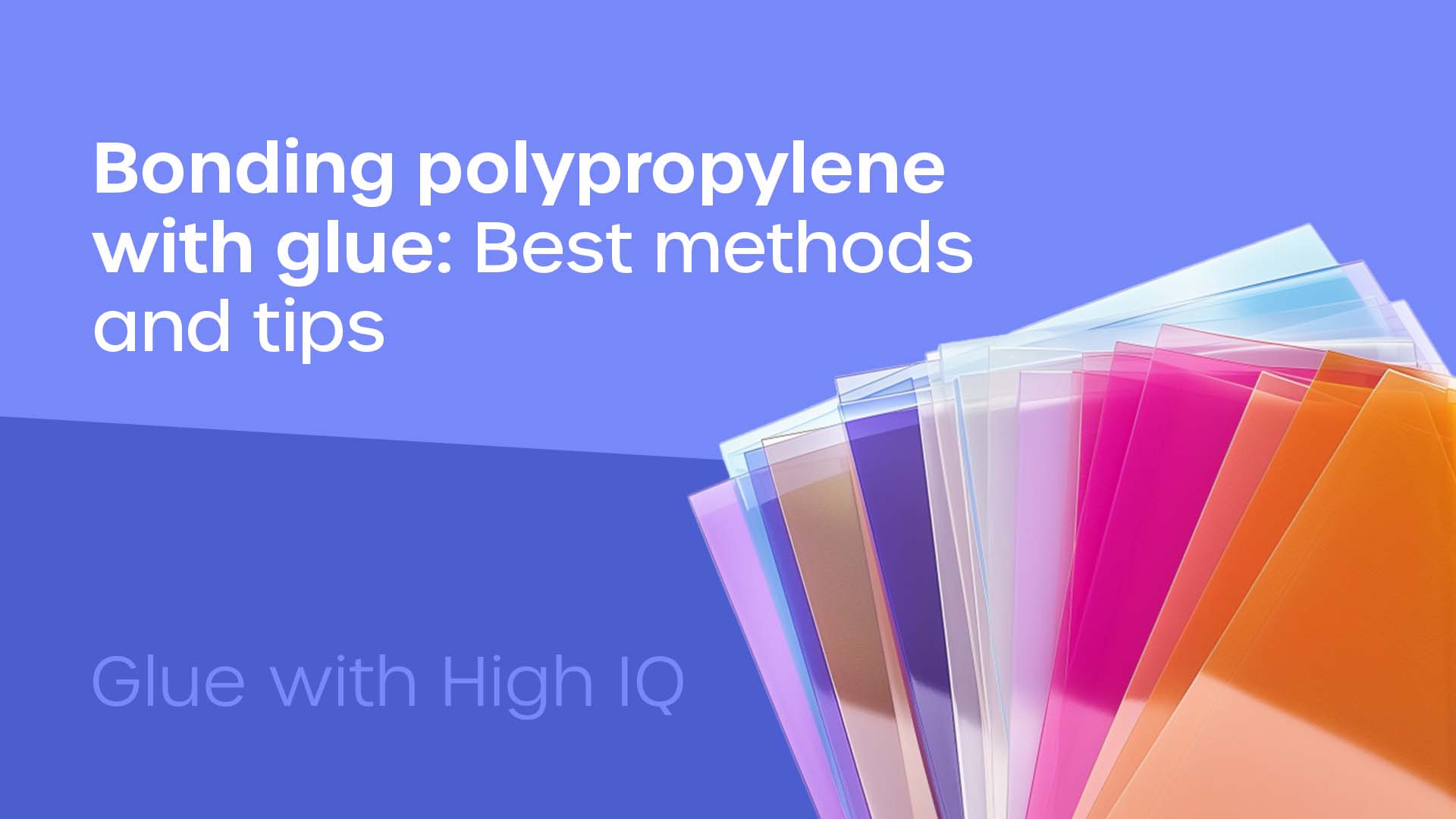
Bonding polypropylene has traditionally been a difficult task. There are, of course, multiple different methods of bonding polypropylene that we will discuss in this article. But perhaps the most difficult is finding a suitable polypropylene glue.
Here at Forgeway, we are frequently asked two questions about polypropylene glue. The first is “how do I bond polypropylene?” The second is “what is the best type of polypropylene glue?”
Trying to bond polypropylene with glue is a problem. This is part of a wider issue around certain types of plastics. It’s such a common question that we wrote an article about it.
That article did not go into much detail about polypropylene though. And because we get asked questions specifically about polypropylene too, we decided to write another article on this topic.
We should point out though, Forgeway does provide a primerless polypropylene glue. It is called Purok VX 90 but selling our product isn’t the purpose of this article.
If you are just looking for a polypropylene glue and don’t want to read the whole article to find the answer, you can watch the video review below to find out more about our Structural Plastic Adhesive.
However, if you are looking for a bit more insight into this topic and want to learn some tips and methods of bonding polypropylene, you are in the right place.
The ultimate goal of this article is to educate you, the reader. The next time you (or someone you know) faces this problem, you will know what the problem is, and what you can do to sort it.
After you have finished reading, you will become an educated buyer.
Background to Polypropylene
To begin with, we will give some context and background to the issue around polypropylene and why it’s difficult to bond with some structural adhesives.
Worldwide, polypropylene is the second most used plastic after polyethylene. (Incidentally, polyethylene is also difficult to bond with adhesives). Polypropylene is everywhere. The phone or computer you are reading this on will likely have polypropylene on it somewhere.
Why polypropylene is so popular
Polypropylene is one of the most popular plastics to use in the manufacturing industry. For good reason too. It has good chemical resistance, is low cost, and has a very high strength-to-weight ratio.
It has a high heat resistance and some grades can even have the same impact resistance as ABS. These factors, coupled with the chemical resistance, make it a very popular material to use in the automotive industry.
Due to its versatility, automotive manufacturers use it in a variety of different situations. Panelling, cladding and composite panels are all examples of where manufacturers would typically use polypropylene.

Why polypropylene is difficult to bond
The difficulty arises when it comes to bonding polypropylene with glue. Some plastics are difficult to bond with glue.
In summary, a material’s surface energy is what affects its ability to form a good bond. And furthermore, the surface energy of the adhesive should be lower than that of the substrate to be able to achieve long-lasting adhesion.
The bottom line is, some plastics have a very low surface energy and therefore bonding to them can be a challenge. Polypropylene is one of those plastics.
That’s not the only difficulty when it comes to bonding though. Because polypropylene is so versatile and popular, not every method of bonding will work in the different situations it is used. That may be confusing, so here’s an example.
Polypropylene is being used on a vehicle and because of its excellent heat and chemical resistance properties, the manufacturer can bond it next to the exhaust. However, there isn’t much space around the fixture so the manufacturer will struggle to bond with mechanical fasteners. The remaining option is to use adhesives, but that’s not very easy either because polypropylene has a low surface energy.
This is just one example. There are many other examples where certain methods of bonding don’t work. That’s why you need to establish what method of bonding will suit you.
Different methods of Bonding Polypropylene
There are a few things to note before we get into the best methods and tips for bonding polypropylene with glue. There are other methods of bonding polypropylene. Using glue is just one method. We will go through the most common and highlight why they may (or may not) be a good option for you.
There are three main methods that manufacturers use to bond polypropylene. Welding, mechanical fasteners, and adhesives.
Plastic welding can only take place between two plastics. The two plastic surfaces are heated (so they melt), clamped together, and left to dry in order to fuse together. It is a very common method of bonding because it forms a strong bond and it’s easy to do.
There are some drawbacks to plastic welding though. It is very difficult to weld plastics in confined spaces. This is also the case when there are small plastic parts that don’t have a large surface area.
Plastics are also susceptible to weakening in the welding process. The heat can damage the structural integrity. These factors are why some manufacturers are less inclined to use this joining method.

Mechanical fasteners are, perhaps, one of the most tried and tested methods of joining. I’m sure you will be well aware of how mechanical fasteners work at this point.
In case you don’t know much about them, they are commonly known as screws, rivets or bolts. The installation process is simple – measure and mark where you want the fastener to go, drill a hole, and screw or bolt it in place. It’s a very popular method because it is so simple and it works.
There are a few problems with this method of bonding. Mechanical fasteners can also affect the structural integrity of the plastic. The process of drilling a hole through the plastic can weaken it. Although there are solutions to reduce this problem, manufacturers often view this method as unnecessarily difficult. This is particularly the case with Polypropylene.
The final method of bonding is to use a polypropylene glue. We touched on this topic earlier in the article, but we will discuss it in more detail here. You must consider whether you want to use a specialist or non-specialist glue to bond polypropylene.
Ensuring your polypropylene glue provides an effective bond
By now, you will have read about the background to polypropylene and some of the different methods of bonding. But adhesives are different, this section discusses why.
If you haven’t already, we advise you read the article about bonding plastics. It will provide a holistic view of the topic we are about to discuss.
Ultimately, polypropylene has a very low surface energy (typically 29 mJ/m²) making it a low surface energy (LSE) plastic. This means that most glues will not be able to adhere to the surface of polypropylene effectively as most common adhesives do not have a surface energy below 38mJ/m². Remember, the surface energy of the adhesive must be lower than that of the substrate it is bonding.
Does this mean you must use a specialist glue to bond polypropylene? No, it doesn’t. The point we explained in the other article is that yes, you can bond LSE plastics with non-specialist glue, but it is very difficult.
Surface pretreatment methods are available. These enable the use of non-specialist glue.
Chemical pretreatment is a fairly cheap process but must be carried out correctly. It involves applying chemicals (for example a primer) to the plastic’s surface. In the example of the primer, the primer interacts and bonds to the polypropylene which then leaves a new surface for the adhesive to bond to. This is an effective bonding method because the surface of the polypropylene now has a higher surface energy. It is a difficult process to get correct, but it works.

Mechanical pretreatment isn’t quite so difficult to carry out but it is more time-consuming. It involves ‘roughing up’ the plastic’s surface with sandpaper or sandblasting. This method of surface pretreatment isn’t always effective. This is because it doesn’t take away from the fact that the surface energy of the plastic is still lower than that of the adhesive. Most manufacturers tend to stay away from this method for LSE plastics.
Physical surface treatments (also known as plasma, corona, or flame treatment) are techniques where the substrate surface is cleaned and chemically modified by exposure to highly energetic charges or other ionic species. This method is significantly more expensive and isn’t always effective depending on your application.
So there are ways to get around using a specialist adhesive. However, you have probably noticed by now that they are all complicated and involve additional cost.
Bearing that in mind, the other option is to find glue with a lower surface energy than polypropylene. This will enable you to bond the polypropylene without having to treat the surface beforehand.
But they are difficult to find. Not all adhesive manufacturers have low surface energy glue options available and they have only recently come to market. Only a select few adhesive manufacturers supply them.
Specialist or non-specialist polypropylene glue: which is best for you?
If you haven’t already gathered, most bonding methods for polypropylene are difficult to put into practice. Because of the pretreatment required, using non-specialist glue is no exception. In our opinion, we believe that the easiest solutions are to use chemical pretreatment or to use a specialist glue.
But that is our opinion. You may feel as though one of the other methods would be an easier method of bonding.
But if you were to choose a specialist glue, what do you need to look for?
Here at Forgeway, we manufacture a range of adhesives. We know what you will need to look for when choosing a specialist glue to bond your polypropylene.
The most important thing to remember is to ensure the surface energy of the glue is lower than that of the polypropylene. So any glue that you are looking at must have a surface energy lower than 29 mJ/m².
If the glue doesn’t have this, it will not bond effectively to your polypropylene without surface treatment methods.
You also mustn’t forget about any other requirements you need the glue to meet. Durability, cure speed, and strength are all common factors to consider.
So, where can you find a specialist polypropylene glue?
We know that there are adhesive solutions provided by some adhesive manufacturers. You may want to conduct some more research to determine other adhesive manufacturers who may be able to provide a solution. Nonetheless, we know it can be very difficult to find a manufacturer who supplies this solution.
Here at Forgeway, we do provide polypropylene glue that has very low surface energy. It’s called Purok VX90 and it will bond your polypropylene. We would be more than happy to help you with this solution if you feel it is the best fit.
Thomas is the Content Manager here at Forgeway. Thomas' job is to translate the technical jargon from the ivory tower of academia into easy-to-read content that everyone can understand. Forgeway's mission is to answer every question our customers and prospective clients ask, or are apprehensive to ask.



